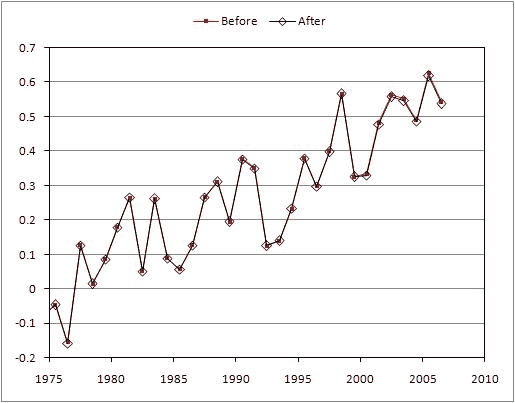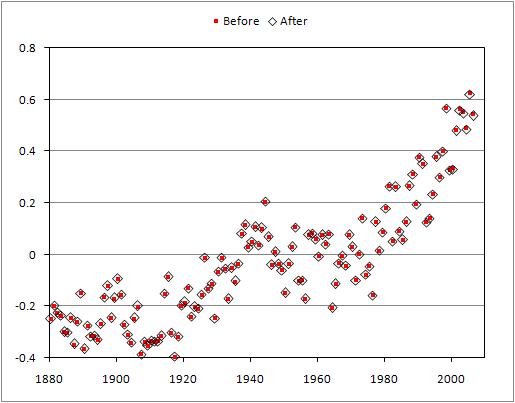Was 1934 the hottest year on record?
What the science says...
| Select a level... |
 Basic
Basic
|
 Intermediate
Intermediate
| |||
|
1934 used to be the hottest year on record in the USA (2012 is now the hottest by a wide margin), but the USA only comprises 2% of the globe. According to NASA temperature records, the hottest years on record globally are 2005 and 2010. |
|||||
Climate Myth...
1934 - hottest year on record
Steve McIntyre noticed a strange discontinuity in US temperature data, occurring around January 2000. McIntyre notified NASA which acknowledged the problem as an 'oversight' that would be fixed in the next data refresh. As a result, "The warmest year on US record is now 1934. 1998 (long trumpeted by the media as record-breaking) moves to second place." (Daily Tech).
Steve McIntyre's discovery of a glitch in the GISS temperature data is an impressive achievement. Make no mistake, it's an embarrassing error on the part of NASA. But what is the significance?
NASA's "Y2K" glitch
Contrary to many reports, the error wasn't a Y2K bug but a mixup over data corrections with the NOAA. NASA GISS obtain much of their temperature data from the NOAA who adjust the data to filter out primarily time-of-observation bias (although their corrections also include inhomogeneities and urban warming - more on NOAA adjustments). From January 2000, NASA were mistakenly using unadjusted data.
USA temperature versus global temperature trends
What is often overlooked is the temperature adjustments in question only applied to temperatures in 48 U.S. states. The U.S.'s land area accounts for only 2% of the earth's total surface area. Thus this has had infinitesimal effect on global trends.
The graph below (courtesy of Open Mind) compares the global temperature trend from before and after adjustments. Before the error was discovered, the trend was 0.185°C/decade. After corrections were made, the trend was still 0.185°C/decade. The change to the global mean was less than one thousandth of a degree.

Figure 1: Global temperature anomaly before (red squares) and after (black diamonds) NASA's "Y2K" corrections (Open Mind).
Last updated on 15 January 2013 by dana1981. View Archives































 Arguments
Arguments






































The difference between the temperature record before the Y2K correction (red dots) and after the correction (black diamonds) is insignificant anytime before 2000 and still barely noticeable after 2000. The change has had practically no detectable impact on the global warming trend over the past 30 years. As for the zero point, temperature anomaly graphs take an average over a specified period (eg - 1960 to 1990) - the temperature anomaly is the difference from this average. The period selected is arbitrary (GISS and CRU use different time periods) as the trend will be the same regardless.